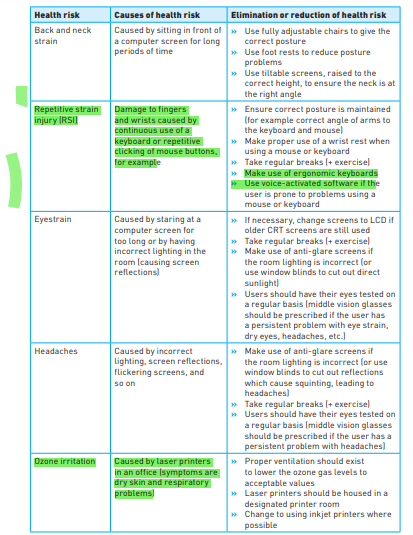The Effects of Using IT (chapter 5)
5.1 Microprocessor - controlled devices
Using microprocessor-controlled devices in the home can have positive and negative effects on our:
lifestyle
leisure time
physical fitness
data security
social interaction
Many common household devices are now fitted with microprocessors to control a large number of their function.
The devices fall into two main groups
Labour-saving devices (group 1)
automatic washing machine
automatic dishwashers
robotic vacuum cleaners
smart fridge and freezers
microwave ovens
cookers
bread-making machines
> A microprocessor-controlled labour-saving device allows people to get on with other things while the device carries out their tasks
Other devices (group 2)
alarm clocks
television sets
central heating and a/c systems
mobile phones and tablets
home entertaining systems
> Microprocessors in this group of devices make them easier to use and give them additional features.
Lifestyle, leisure time and physical fitness
The effects of microprocessor-controlled labour-saving devices on a person’s lifestyle, leisure time and physical fitness.
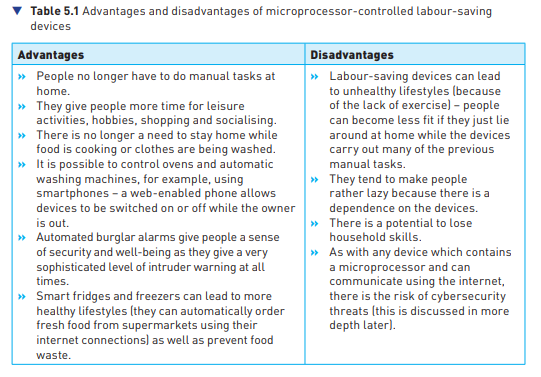
The effect of microprocessor-controlled device in general ways affect our lives (not necessarily labour-saving devices, simple use to improve their functionality)
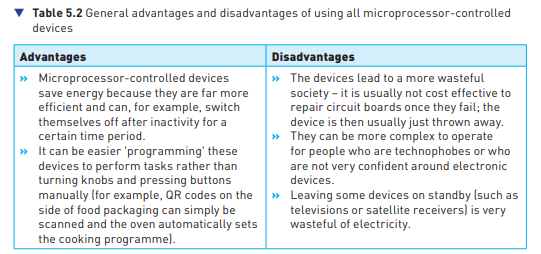
Data Security Issues
Any household device which can be remotely-controlled could allow a hacker to gain personal data about you.
These devices are often set with a default (or no) password, making it easy for cybercriminals to obtain personal details.
Ex: If the fridge/freezer automaically orders food from a supermarket, then it is possible for a hacker to gain key data, such as credit card numbers
It is therefore important to manage passwords and also install software updates, which often contain new security features.
Social Interactions
Microprocessor-controlled devices impact social interactions both positively and negatively.
Some devices encourage outdoor activities, while others promote staying at home.
Smartphones, smart TVs, and tablets enable remote communication via VoIP, emails, or chat rooms.
POSITIVE ASPECTS
Easier to make new friends using chat rooms
Helps find people who share similar interests/hobbies
VoIP technology is a cheaper way to stay in touch
NEGATIVE ASPECTS
Less face-to-face interaction, leading to social isolation
Lack of social interaction, increases anxiety when meeting people in real life
Online behaviour can often be rude or aggresive and cyber bullying is a real problem, particularly for young people.
5.1.2 Monitoring and Controlling transport
the use of microprocessors in transport systems is becoming more and more widespread
Examples of where they are currently being used
monitoring of traffic on motorways
congestion zone monitoring
automatic number plate recognition (ANPR)
automatic control of traffic lights
air traffic control systems
railway signalling systems.
Control of smart road systems and smart signs
Many modern motorways are called smart motorways BECAUSE Monitoring, traffic control, and motorway sign information are managed by a central computer system.
In case of accidents or congestion, smart motorway signs help redirect traffic to avoid accidents or further delays.
Traffic lights in cities are also managed by computer systems.
Security concerns:
If these systems are hacked, it could cause chaos.
Hackers could gain control over sections of the road network.
This poses significant safety and security risks.
Rail and airline network control systems
Computerised monitoring systems help coordinate trains and aeroplanes entering and leaving stations/airports.
Total computer control allows for a more efficient timetable.
Safety improvement: Human error is removed, reducing rail accidents caused by driver mistakes.
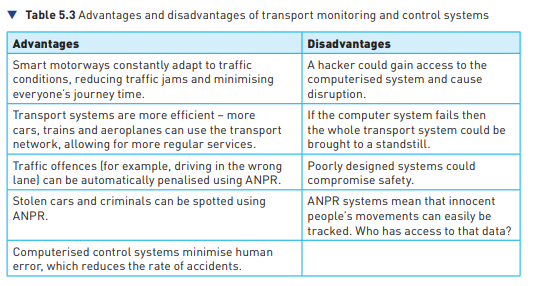
Autonomous Vehicles in Transport
Here are the notes based on the content of the images in order:
1. Autonomous Vehicles in Transport:
- Driverless (autonomous) vehicles are becoming more common.
- The main challenge is human perception, not technology.
- People are hesitant to ride in autonomous cars or planes without pilots.
- Autonomous trains are widely accepted because they follow specific tracks and do not overtake other trains.
2. Autonomous Cars, Buses, and Vans:
- Autonomous cars use sensors, cameras, actuators, and microprocessors with complex algorithms.
- Sensors and cameras act as the "eyes" of the car, detecting road conditions.
- Microprocessors process data and send signals to actuators for actions like changing gears, applying brakes, and turning the steering wheel.
- Radar and ultrasonics help build a 3D image of surroundings, especially in poor visibility.
- Example: An autonomous car approaching a red traffic light will recognize the sign, apply brakes, and shift to park. It will monitor until the light turns green, then shift to first gear, release brakes, and accelerate.
3. Security and Safety When Using Autonomous Vehicles:
- Autonomous vehicles rely on sensors, cameras, and microprocessors, making them vulnerable to cybercriminals.
- Hackers can block sensor information or send false data, potentially accessing personal information or tracking the vehicle.
- Security risks apply to cars, trains, and planes.
- Despite risks, autonomous transport can improve safety by removing human error and enhancing environmental awareness.
Advantages and Disadvantages specific to autonomous vehicles
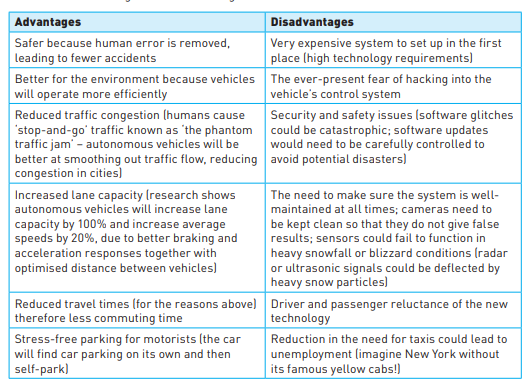
Autonomous Trains
Autonomous (driverless) trains have been operational in many large cities for several years.
- They utilize sensors, cameras, actuators, and on-board computers/microprocessors.
- LiDaR (Light Detection and Ranging) technology uses lasers to create a 3D image of the surroundings.
- Other sensors, such as proximity sensors on train doors, and cameras, including infrared cameras, are used for control and safety.
- Global positioning satellite (GPS) technology helps in accurate speed and direction changes.
- Actuators control the train’s speed, braking, and door operations.
- These systems significantly improve safety.
Advantages and Disadvantages of Autonomous Trains

Autonomous (pilotless) aeroplanes
Aeroplanes have used auto-pilots for many years, primarily controlled by human pilots during take-off and landing.
Pilotless aeroplanes would extensively use sensors, actuators, and microprocessors to control all flight stages.
Key features of the control system include:
Sensors to detect turbulence for smooth flights.
Increased self-testing of all circuits and systems.
Sensors to automatically detect cabin depressurization for quick stabilization.
Use of GPS for navigation and speed calculations.
Actuators to control throttle, flaps, and other flight mechanisms.
Advantages and Disadvantages specific to pilotless aeroplanes

5.2 Potential health problems related to the prolonged use of IT equipment
Most common health risks and ways to eliminate or reduce the risk:
